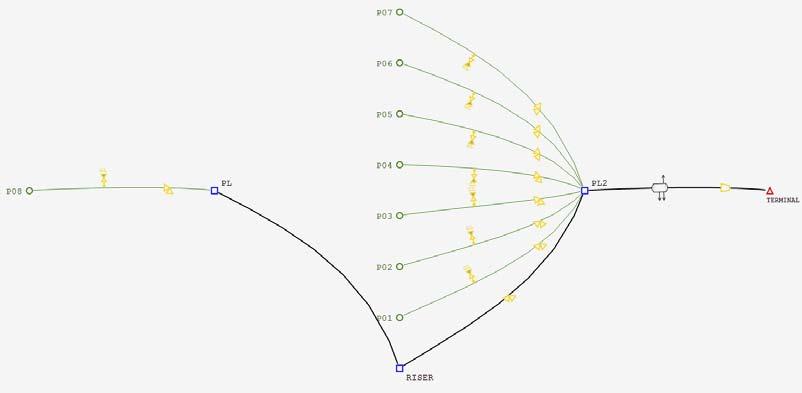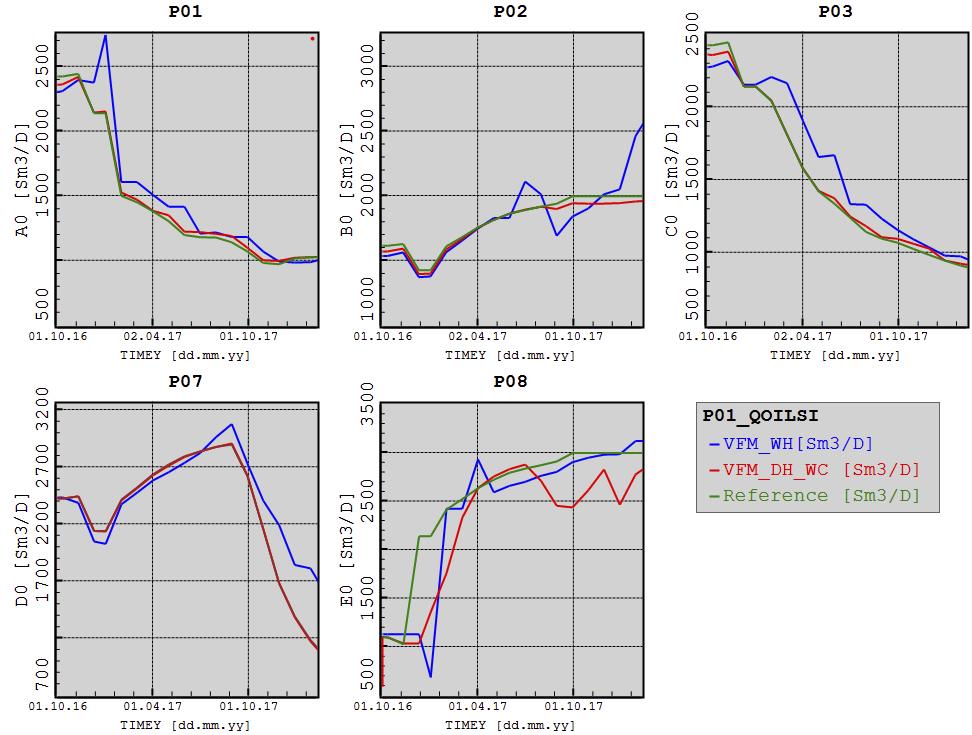
13 minute read
A sense of what is to come





Stian Engebretsen, Aurore Plougoulen, and Lars Anders Ruden, Emerson Automation Solutions, describe an IIoT powered digital metering solution, which couples sensors, multiphase meters and virtual flow metering.


In the upstream oil and gas industry, multiphase metering is a central part of many applications and processes, such as reservoir management, field development, operational control, flow assurance and production allocation. In this context, the implementation of Industrial Internet of Things (IIoT) systems unlocks online production monitoring and allows field operators to monitor their wells and obtain real-time and continuous well information. Multiphase flow meters (MPFMs) and virtual flow metering (VFM) can be combined to provide operators with a reliable solution powered by IIoT to estimate the in-situ flow of oil, gas and water within wells and flow lines. This article addresses the combination of MPFM and VFM systems and illustrates the technology with two use cases: one where MPFMs are the main well allocation method, and the other where VFM is used as the main well allocation method.


Technical introduction to the concept of MPFMs and VFM
Multiphase flow metering is the task of estimating the fluid phase flows of (typically) oil, gas and water within pipes such as wells and flow lines. In the upstream oil and gas industry, multiphase metering is a central part of many applications and processes, such as production control, reservoir/production monitoring and optimisation, and production allocation. The main problem is measuring the contents flowing inside the pipes in near real-time without significantly aff ecting the process. The traditional way of measuring the production of a well is to route the fluids through a test separator for a given period and measure the single-phase flow at the outlets using accurate, fit-for-purpose meters.

However, frequent well testing reduces production regularity and introduces additional pressure loss, hence the need for a solution that lowers overall costs, minimises disruptions from periodic well testing, and enables accurate measurement of the contents flowing inside the pipes.
During the 1990s, two similar but diff erent methods of multiphase metering emerged onto the market, where sensor measurements were used to estimate the in-situ flow – MPFMs and VFM. Advances in both sensor technology and the computational power of computers were enablers of these technologies. Sensors measure intrinsic properties of the flowing media with high accuracy, such as pressure and temperature; measurements are then converted into flow rates using a metering system. A MPFM is installed directly in the flow trajectory and uses the combined measurements from multiple sensors to estimate the flow rates through the meter. Virtual metering relies more heavily on the mechanistic flow models, but similarly to MPFM, it uses sensor measurements as input to estimate the flow rates – the sensors can be located at diff erent locations throughout the flow trajectory.
Figure 1. Schematic of equipment and sensors for a well with a multiphase flow meter. The active components used by the VFM in this example are shown in black – pressure and temperature sensors, water fraction and venturi from MPFM and choke

Since the 1990s, much has happened on diff erent technology fronts: while sensors, data acquisition and soft ware have known great innovations, the IoT trend has created the IIoT.
Sensing Sensors for pressure and temperature have become more accurate and reliable. Downhole gauges for pressure and temperature are now a proven technology with better accuracy and reliability, and data attenuation. Downhole gauges are important for VFM, as they enable flow models to be matched against the response from downhole to wellhead.
Figure 2. Flow rate results from MPFM and VFM vs time using instrumentation as shown in Figure 1. The relative errors between MPFM and VFM are in the range of 10 – 15% in the left half of the plot and 3 – 5% in the right half.

Figure 3. Emerson’s web application dashboard displays real-time inputs from the field and estimated flow rates vs time. The near real-time equipment inputs are shown in a list on the right. Data acquisition Diff erent data acquisition systems, such as supervisory control and data acquisition (SCADA), distributed control systems (DCSs) and production historians, can aggregate hundreds of thousands of data points from oil and gas fields down to second interval sampling. Data acquisition systems are now able to push production data to cloud solutions, an enabling technology for digital transformation.
Software Innovations in algorithms as well as hardware improvements have resulted in greater capacity for modelling big systems close to real-time. With available data from real-time data acquisition systems, online production monitoring is enabled and can be deployed in cloud-based solutions.
A virtual metering system is a true IIoT application, in the sense that it is enabled by distributed sensor and equipment information which is gathered by an acquisition system and analysed using a dedicated soft ware application. VFM is a combination of separate systems which return great benefits.
There are two main approaches to VFM – model-based and data-driven utilising machine learning (ML). Since ML needs data to train models to be predictive, the models will obtain more data for training. Both approaches have pros and cons, as production continues. This article will focus on model-based VFM, which relies on mechanistic multiphase flow models that have predictive capabilities out of the box, but like ML, are vastly improved with available calibration data. For this method, a representative model of the production system must be built using the fluid properties
and the static model information (well and flow line trajectories, location of equipment and sensors, etc.). The model is then calibrated using available data such as well tests, MPFM, or metered data from separators.
VFM for assistance, backup and validation of the MPFM system
MPFM is used both in subsea and onshore contexts and can be installed directly on wellheads or on flow lines. MPFM is typically installed on high producing wells where the investment is justified or where accurate production allocation is important, such as for custody transfer between operators. For fiscal metering, accuracy is naturally an important factor given the economic consequences, and that is where virtual flow metering in combination with MPFM adds further capabilities in data validation, to increase confidence in the flow rate allocation. VFM incorporates all relevant measurements in a gathering system; depending on the available instrumentation/sensors, it provides an independent system that can validate the results from installed MPFM and add backup. This is crucial when accuracy and robustness are of major importance.
An example is considered where MPFM is installed on the wellhead of an oil producing well. The example illustrates the multiphase metering capabilities of VFM when downhole gauges, wellhead sensors, venturi and water fraction estimates from MPFM are available, in addition to reference data for model calibration. Figure 1 shows the active equipment used for the calculation (black) and the inactive components (pink).
With the available instrumentation presented in Figure 1, results are shown in Figure 2 for the oil phase. The results show a good qualitative match between MPFM and VFM, though with larger relative errors seen in the period represented in the left half of the plot. For this setting, VFM is partially dependent on MPFM due to the water fraction estimates, but the downhole sensors enable VFM to match the model with the pressure loss in the well bore, resulting in a decent match with MPFM and VFM.
Engineers and operators can diagnose sensors and equipment by comparing results from VFM and MPFM. Divergence and systematic drift may indicate problems with the instrumentation or be a sign of solids precipitating within the pipes. In the event of the flow being compromised, it is valuable to have a VFM system assisting the MPFM with diagnosis when expensive remedial actions are being considered.
With MPFM available, there is also the possibility of using the flow rates as input to the VFM and comparing the sensor deviation output by the VFM. In such a setting, the VFM is mainly used as a validation system, but it may still give an additional view into the production system.
Using a near real-time VFM system for production monitoring can be a powerful tool for gaining insight into the production system and reservoir. Physical properties from the VFM model can be extrapolated and shown at any position in the flow trajectory, such as downhole or downstream in the gathering network. Erosional velocity limits, hydrate formation temperatures, and liquid hold-up or other parameters of interest can be viewed at key locations in near real-time. User interfaces may provide direct insight to the online results, showing the match of diff erent sensors and instrumentation. In the dashboard in Figure 3, an example is shown where the calculated and measured properties are displayed on the right. Operators and engineers may use this information to diagnose and fix operational problems more quickly, which in the long run leads to more eff icient production.
VFM as the main well allocation system with assistance of MPFM
VFM can be used to estimate flow rates in a production system given the right instrumentation. As a bare minimum, wellhead sensors measuring pressure and temperature are needed, but if these are the only sensors available, regularly performed well tests are required for fixing fluid ratios. MICRO AND NANO CONNECTORS FOR EXTREME ENVIRONMENTS

THE PETROLEUM-INDUSTRY T MICRO AND NANO SIZED CONNECTORS ARE SPECIFICALLY DEVELOPED S FOR THEIR SMALL SIZE AND F RUGGEDNESS, TO PROVIDE R HIGH TEMPERATURE, HIGH H DENSITY AND HIGH SHOCK D RESISTANCE COMMONLY NEEDED IN DOWN-HOLE, RESEARCH AND RESERVE EXPANSION.

WWW.OMNETICS.COM | SALES@OMNETICS.COM | +1 763-572-0656
Your business partner in • Oil & Gas Industry • Geothermal Industry SINCE 2006

STOP COLLARS Heavy Duty Stop Collar, Bevelled Edge/ Slip-on Stop Collar (2 7/8” - 13 3/8”) More than 1 million rings have been supplied worldwide since 2006.
CENTRALIZERS Wide range of Steel and Composite Centralizers in accordance with a client needs and drawing documentation.
More Information: www.trimos-sro.eu

Figure 4. The output from the network simulation shows the variations in GOR and WC for the five wells.

Figure 5. Network topology for the two VFM examples. Wells P01, P02, P03 and P07 are producing to a wellhead platform and P08 is a satellite well coming into the same platform.

Figure 6. Flow rates of oil estimated by VFM using two diff erent instrumentation configurations. The VFM_WH uses monthly well tests together with wellhead pressure and temperature. The VFM_DH_WC uses wellhead pressure and temperature, WC measurements and downhole gauges, but it does not rely on well tests. The green reference value shows the simulated ‘truth’ which the blue and red are trying to reproduce.
Table 1. Average relative errors in % comparing the oil rate of VFM results with simulation results
P01 (%) P02 (%) P03 (%) P07 (%) P08 (%)
VFM_DH_WC 1.7 1.6 1.54 0.3 17.54
VFM_WH 6.86 6.37 8.56 9.08 20.19
In the following examples a simulator is used to model five wells producing to a common wellhead platform. The results from the simulator are then used as input for a second VFM calculation, applying only pressure and temperature sensors at the wellhead, choke and gas lift settings, and fixing gas-oil ratio (GOR) and water cut (WC) once a month to see the eff ect of regular well tests. The GOR and WC in the individual wells vary between well tests, and consequently, the accuracy of the well test-based calculation will be significantly aff ected. Figure 4 shows the simulated GOR and WC for the five wells. The GOR in well P08 is rapidly changing from 1200 down to below 200, and well P07 and P02 are increasing relatively quickly in WC. The resulting oil rate from the VFM is shown in Figure 5, labelled VFM_WH.
A second example is now considered based on the same simulation, where the downhole gauges and real-time WC measurements per wellhead are used in addition to the wellhead sensors. Downhole gauges enable measurement of the pressure diff erential representing both gravitational and frictional loss, which is key to obtaining reliable results in VFM. WC measurements from a simple MPFM are required here to estimate the multiphase flow, as three phases (oil, water and gas) are produced from the reservoir. Using MPFM and downhole gauges allows measuring of the WC and to estimate the GOR with the VFM system. Thus, the well tests are no longer needed to fix the WC and GOR. The results are shown in Figure 6, labelled VFM_DH_WC.
The same model foundation is used to both simulate the field responses and for VFM; thus, errors in fluid properties, sensor measurements, choke valves and gas lift rates are not introduced. These two VFM examples highlight the impact of available data on the accuracy of the oil rate metering. The average relative errors in the oil rate for the two diff erent cases are shown in Table 1. The table shows that using monthly well tests to fix GOR and WC and utilising wellhead sensors for the VFM result in an averaged relative error of ±6 – 9% on wells P01, P02, P03 and P07, while using additional equipment such as downhole gauge and MPFM reduces it further to 2%. Well P08 has a rapid change in GOR (Figure 5), which poses challenges to both approaches, as indicated by the larger errors for this well.
Conclusion
Combining MPFM and VFM systems provides field operators with a flexible solution that can be adapted to their needs and constraints to measure the contents flowing inside the pipes in near real-time, without significantly aff ecting the production process. Assisting, backing up or validating the MPFM system with VFM not only increases operator confidence in the flow rate allocation, but also enables early identification of metering deviation. While using VFM as the main well allocation system can represent a more cost-eff ective solution, the choice of the main technology to use should reflect the profitability of the production system and the expected accuracy.
Powered by IIoT systems, the featured multiphase flow metering technology is improving the speed and accuracy of decision-making and corrective actions. Bringing together IIoT devices and web applications provides engineers and operators with access to real-time inputs from the field and estimated flow rates vs time. This real-time flow of information enables them to diagnose and fix operational problems more quickly, leading to more eff icient production. The digital transformation in multiphase flow metering is just one illustration of how leveraging the IIoT is helping oil and gas industries to gain a competitive advantage.










